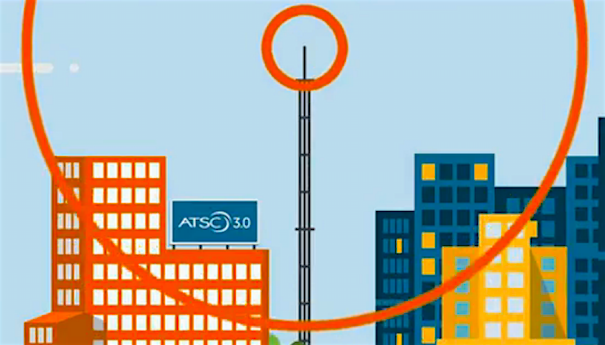Strategies for Making a Smooth Transition to NextGen TV
The case for channel sharing

As U.S. broadcasters transition to ATSC 3.0, one of the biggest challenges the industry faces is the shortage of available spectrum to deliver a diverse multiplex of channels and the availability of low-cost, last-mile internet connectivity. The repack is complete, but broadcasters need to avoid disrupting the current business workflow while successfully transitioning to ATSC 3.0. The only practical solution is one based on channel sharing.
To start a channel share, the logistics of cross connecting two or more stations is not complex. The broadcast industry has a wide range of tools to facilitate this. Cross connecting two or more stations will increase a station’s opex, and the price magnitude will vary between markets.
The transition to ATSC 3.0 is starting in mid-size markets mostly because broadcast spectrum is available, and the price of high-speed internet is not cost prohibitive. Stations in top-10 designated market areas (DMAs) will have readily available low-cost internet but little to no available spectrum; therefore, they will require very careful planning and a very high-density broadcast delivery solution to start broadcasting NextGen TV.
Conversely, stations in markets 150 and higher will likely have plenty of broadcast spectrum but very few and costly internet choices. This article will discuss strategies for enhancing ATSC 1.0 signals to leverage the available spectrum capacity, along with must-have capabilities in an encoding solution to ensure optimal efficiency for high-quality video delivery over the internet to smoothly usher in the ATSC 3.0 era.
OPTIMIZING LEGACY 1.0 SIGNALS AND IMPROVING OVERALL SPECTRUM CAPACITY
By leveraging several key technologies and video profiles—either separately or in combination—broadcasters can streamline channel-sharing workflows while preserving picture quality.
The first technology that is crucial to enhancing the quality of broadcast signals is statistical multiplexing or “statmux,” a process synonymous with creating a variable bit rate (VBR) video profile by linking the multiplexer with the encoder in a feedback loop. Compared to constant bit rate (CBR), VBR greatly preserves video quality no matter the complexity of the content. If stations are not leveraging VBR technology in their multiplex today, they will be soon as this technology is responsible for delivering a 33% or more bandwidth saving with four or more streams when compared with the same multiplex using CBR only. Statmux technology has improved over the years but within the last two years has made a significant jump, allowing for several advantages not possible before, but more on this later.
ATSC 1.0 broadcasters may choose from 18 video profiles but three dominate the landscape: one SD and two HD. The source and coding profile to deliver video will impact how much bandwidth is needed to deliver a channel. It’s worth noting that TF1 in France has removed all SD formats, upconverting its old libraries making an all HD multiplex. The consumer response has been positive. DVB broadcasters like TF1 also have the advantage of using a more robust codec than ATSC 1.0.
The professional video industry's #1 source for news, trends and product and tech information. Sign up below.
Fortunately, ATSC 3.0 stations will jump to HEVC and be able to choose from a much wider variety of profiles to drive more than one PLP (physical layer pipe) delivery. Downconverting HD profiles can save as much as 20% to 60% in bitrate savings. Additionally, the AVC video codec offers a 50% bitrate reduction compared with MPEG-2, and stations operating in big markets like Los Angeles, are using it now to preserve video quality with less bandwidth for ATSC 1.0 transmissions. This trend is expected to continue as channel density requirements continue to increase while consumers replace their older equipment.
MUST-HAVE ENCODING CAPABILITIES FOR ATSC 3.0
High-efficiency encoding is a critical component for broadcasters in general, but more so for channel-sharing operations considering the move to ATSC 3.0. To make the most of spectrum capacity, there are a few essential capabilities to look for in an encoder.
For instance, the encoding solution must offer inputs for merging SDI and IP content, as stations will be delivering or combining their signals with other ATSC 1.0 and or ATSC 3.0 facilities for the foreseeable future.
The encoding solution must also be capable of supporting multiple types of codecs, including MPEG-2, AC-3, AVC, HEVC and AC4. This is important because today a station might be using one codec, but tomorrow their business could change, forcing an adjustment. Complex channel-sharing operations will likely require some additional licensing, wiring more inputs to sources, as well as the ability to simultaneously transcode and encode more services in the same statmux pool.
Furthermore, stations may wish to create split feeds for cable market delivery using a completely different bitrate and/or codec. Broadcast transmissions necessitate high-density multiplexing, with encoding video at the lowest possible bitrate. Conversely, cable operators expect very high quality no matter the bitrate to ensure pristine quality or to provide ad replacement. These are diametrically opposing processes and running both simultaneously will require significantly more processing power, path diversity and complexity, which usually stretches the available equipment beyond its capability for maintaining reliable service.
Broadcast budgets are shrinking, some in favor of more streaming capability. Stations are also looking to reduce capex budget by leasing smaller or fewer facilities, limiting engineering rack space. With ultra-high-density encoding solutions, stations can effectively address both capacity and efficiency concerns with encoders powered by high-performance, next-generation servers. The processing capabilities possible today are far beyond most of the systems deployed as little as two years ago, allowing stations to support more channels, including UHD.
Broadcasters are on-air 24/7, 365 days a year, so redundancy is imperative. If stations aren’t on the air, they’re not making money. Uptime is now characterized in seconds or number of frames per year. It is common practice for system architectures to replicate the entire air chain starting right after the output from master control all the way to the tower. With this responsibility comes the necessity to monitor both paths for maintaining high availability. This necessitates the systems to be protected in a high-security environment with remote access so operators can enjoy more freedom to work from anywhere within the reach of Wi-Fi.
CONCLUSION
Flexibility is critical to navigate these unprecedented times. ATSC 3.0 is a very complex system with enormous advantages, but the COVID-19 pandemic has made the transition from ATSC 1.0 to NextGen TV slower than predicted. The challenges to overcome are immense but not impossible, they just take longer to resolve. By partnering with technology providers who can offer flexible, high-performance, software-based solutions with local support, broadcasters can ensure that the transition will keep running smoothly, while providing exceptional quality.
Statistical multiplexing technology, next-generation audio/video codecs and techniques like video profile down-conversion will all play an important role in the transition to ATSC 3.0. We expect the AVC specification in ATSC A/72 will be leveraged more in ATSC 1.0 operations to either double picture quality or enable the delivery of additional channels as stations enter channel-sharing agreements.
The encoders made today far outperform the capability and capacity of the ASIC-based encoders sold five years ago. Though the old units keep working, the new designs offer industry-leading video quality and workflow flexibility, in a reliable software-based video appliance that now includes support for mixed profile (MPEG-2 and AVC) all in the same statmux pool, a capability not possible in the old silicon designs. This advancement will provide the boost required in ATSC 1.0 to ease the conversion to ATSC 3.0.
Joel Wilhite is senior systems design engineer at Harmonic.
